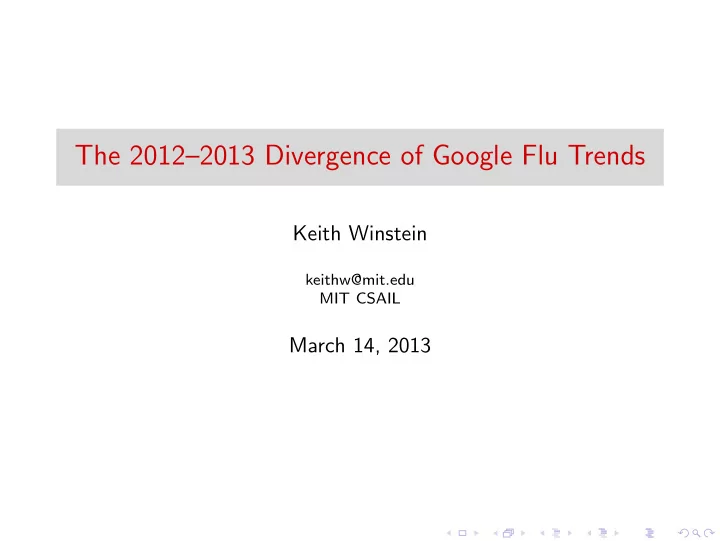

The 2012–2013 Divergence of Google Flu Trends Keith Winstein keithw@mit.edu MIT CSAIL March 14, 2013
The premise ◮ CDC ILInet flu surveillance is slow ◮ 12 days from start of MMWR week ◮ 5 days from end of MMWR week ◮ Revised over subsequent weeks ◮ Idea: Real-time estimate ◮ Use Google searches ◮ roughly 40,000 per second Keith Winstein keithw@mit.eduMIT CSAIL The 2012–2013 Divergence of Google Flu Trends
Disease-agnostic training procedure ◮ Gets historical ground truth ( training data ) ◮ Finds search queries that correlate well ◮ Evaluated on held-out verification set ◮ Danger: “oscar nominations” Keith Winstein keithw@mit.eduMIT CSAIL The 2012–2013 Divergence of Google Flu Trends
What is ground truth? ◮ Virological surveillance ◮ Cannot predict well from search data ◮ Influenza-like illness ◮ Fever ≥ 100 ◦ F and (cough and/or sore throat) ◮ Measured as %age of outpatient visits ◮ 1,950 sites report weekly to CDC Keith Winstein keithw@mit.eduMIT CSAIL The 2012–2013 Divergence of Google Flu Trends
Nov. 11, 2008 announcement Keith Winstein keithw@mit.eduMIT CSAIL The 2012–2013 Divergence of Google Flu Trends
NYT figure Keith Winstein keithw@mit.eduMIT CSAIL The 2012–2013 Divergence of Google Flu Trends
Nov. 19, 2008: Publication in Nature Keith Winstein keithw@mit.eduMIT CSAIL The 2012–2013 Divergence of Google Flu Trends
Nature fig. 2 Keith Winstein keithw@mit.eduMIT CSAIL The 2012–2013 Divergence of Google Flu Trends
Accuracy figures Index based on 45 queries (e.g. ”pnumonia”). ◮ Training data (2003–2007): 0 . 80 ≤ r ≤ 0 . 96 (mean 0.90 ) ◮ Verification (2007–2008): 0 . 92 ≤ r ≤ 0 . 99 (mean 0.97 ) “We intend to update our model each year with the latest sentinel provider ILI data, obtaining a better fit and adjusting as online health-seeking behaviour evolves over time.” Keith Winstein keithw@mit.eduMIT CSAIL The 2012–2013 Divergence of Google Flu Trends
High expectations NYT : “In April 2009, Dr. Brilliant said it epitomized the power of Google’s vaunted engineering prowess to make the world a better place, and he predicted that it would save untold numbers of lives.” Brilliant on PBS : “This one little program, done by three engineers, outperforms CDC or WHO’s very expensive surveillance system by two or three weeks. And CDC is thrilled about that. They’re not unhappy. It’s not a competitive issue. They’re really happy. So you can find less expensive ways to know when the flu season is beginning, what states should get the first shipment of vaccine or antivirals, using these technologies.” (May 2009) Keith Winstein keithw@mit.eduMIT CSAIL The 2012–2013 Divergence of Google Flu Trends
Performance in the first year 5% CDC 4% Outpatient visits for influenza-like illness 3% 2% Google 1% 0% 2009 2010 Keith Winstein keithw@mit.eduMIT CSAIL The 2012–2013 Divergence of Google Flu Trends
Aug. 19, 2011: PLoS ONE paper ◮ Training data (2003–2007): Mean correlation 0.90 ◮ Verification (2007–2008): Mean correlation 0.97 ◮ Actual (March–August 2009): Mean correlation 0.29 ! Model retrained in September 2009, now 160 queries. “We will continue to perform annual updates of Flu Trends models to account for additional changes in behavior, should they occur.” Keith Winstein keithw@mit.eduMIT CSAIL The 2012–2013 Divergence of Google Flu Trends
Google Flu Trends plot as of today (http://www.google.org/flutrends/about/how.html) Keith Winstein keithw@mit.eduMIT CSAIL The 2012–2013 Divergence of Google Flu Trends
Most of plot is training data (http://www.google.org/flutrends/about/how.html) Keith Winstein keithw@mit.eduMIT CSAIL The 2012–2013 Divergence of Google Flu Trends
Second divergence in 2012–2013 for U.S. 10% Google Outpatient visits for influenza-like illness 8% 6% CDC 4% 2% 0% 2009 2010 2011 2012 2013 Keith Winstein keithw@mit.eduMIT CSAIL The 2012–2013 Divergence of Google Flu Trends
Large divergence (3 . 7 × ) in New England (HHS region 1) 14% Google 12% Outpatient visits for influenza-like illness 10% 8% 6% 4% CDC 2% 0 2010 2011 2012 2013 Keith Winstein keithw@mit.eduMIT CSAIL The 2012–2013 Divergence of Google Flu Trends
Substantial divergence (+72%) in France Google 1.2% 1% Outpatient visits for influenza-like illness 0.8% Sentinelles 0.6% 0.4% 0.2% 0 2010 2011 2012 2013 Keith Winstein keithw@mit.eduMIT CSAIL The 2012–2013 Divergence of Google Flu Trends
Substantial divergence in Japan Keith Winstein keithw@mit.eduMIT CSAIL The 2012–2013 Divergence of Google Flu Trends
My understanding of Google’s point of view ◮ GFT succeeded at predicting early flu onset ◮ Correlation and RMS error aren’t the end of the story ◮ Primary audience is public health authorities ◮ Independent index ⇒ value-add ◮ Not necessarily trying to get most accurate figure overall ◮ Method is resilient to confounding by media ◮ Prefer not to retrain model if still performing well ◮ Idea is to minimize human influence as much as possible ◮ Don’t show 2008–09 model, because older versions of software not as relevant for estimating performance of current version. ◮ Intend to clarify PLoS ONE vs. Nature and training data vs. verification on GFT Web site ◮ Decline to share 2008–09 data (removed from site) ◮ Decline to discuss Japanese estimate Keith Winstein keithw@mit.eduMIT CSAIL The 2012–2013 Divergence of Google Flu Trends
My questions re: GFT ◮ Why did GFT overestimate this year’s flu activity? ◮ Could several ILInet regions, R´ eseau Sentinelles, and Japanese NIID have had correlated error? ◮ In retrospect, were there clues last summer when decision made not to retrain? ◮ Would more frequent retraining have helped or hindered? Keith Winstein keithw@mit.eduMIT CSAIL The 2012–2013 Divergence of Google Flu Trends
More questions ◮ Can we develop methods that are robust against whatever befell GFT? ◮ Is it possible to measure robustness without waiting five years for results? ◮ Instead of r or RMSE, what about a decision-theoretic measure of accuracy? ◮ Method A is earlier but less accurate ◮ May still allow us to distribute limited vaccines more appropriately than Method B ◮ Model vaccine-distribution policy as function of model estimate ◮ Figure of merit: flu cases averted, QALY gained, $ saved, . . . Keith Winstein keithw@mit.eduMIT CSAIL The 2012–2013 Divergence of Google Flu Trends
Recommend
More recommend